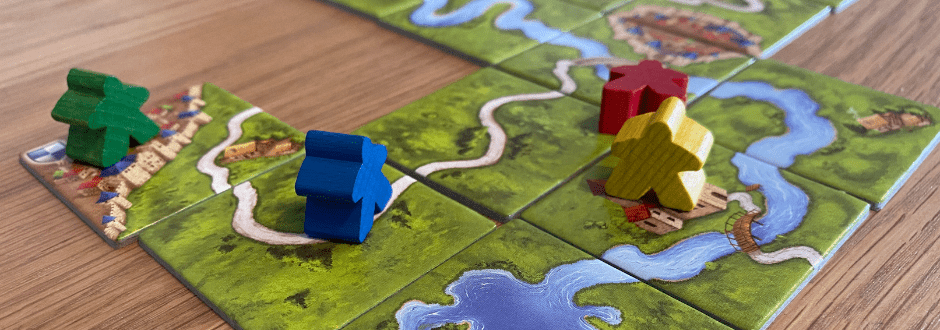Carcassonne Review
Toy Street Posted on:-18-07-24 Reviews,

Today, I’m going to talk to you about a game that so many gamers cite as being their introduction to the hobby. I know it was featured on Wil Wheaton’s Tabletop back in the day and it was something that I played with early in my days of the hobby. I still have my copy of Carcassonne, the devilishly simple tile placement game that introduced the world to the meeple. If you’re looking for a game to introduce to your family, then look no further than a Roman city sat upon a hill in France.
The Game
In Carcassonne, you are simply trying to get the most points by laying down tiles into the landscape and placing meeples out onto those tiles to score. The biggest thing you’ll notice when you set this game up is that the board is just one square tile. It will either be the beginnings of a civilisation with a road and an open city, or the source of a river, if you use the river expansion.
Each player chooses a colour and takes all the meeples of that colour, placing one on the 0 spot of the score track. Then, after choosing a first player, everyone takes it in turns to pick up a tile from the facedown stack and add it to the ever-expanding landscape. These tiles show some combination of roads, cities, farms and monasteries on them. However, the placement is key here, because you have to ensure the following rules are met:
- At least one side is touching another placed tile
- All sides which touch a tile must match their neighbouring tile. For example, a road must connect to a road, a farm to a farm or a city to a city.
When you have placed your tile, you may place one of your meeples down onto a feature that is not occupied by another player. Depending on the feature a meeple is placed into, it takes on a different role: in a field, it is laid down to be a farmer; in a city, it is a knight; on a road, it’s a robber; and on a monastery, it is a monk. Each of these roles scores differently when a feature is completed, so let’s look at those quickly now.
Knights score when a city is completely enclosed by walls, and scores 2 points for each tile involved, plus a bonus 2 points for each shield showing on those tiles. The Robbers score when both ends of the road end at either a crossroads or a city, scoring 1 point for each tile involved. The Monks score when 8 tiles have been placed around it, scoring 1 point for each tile around it and 1 for itself (for a total of 9.) When these three score, you claim back the meeple to use later. Farmers score at the end of the game, scoring 3 points for each completed city connected to their field. This one is a bit trickier to deal with, what with the fields sprawling out all over the place, but you get used to it after a couple of plays.
You may be asking “well, what happens when a city/road/field merges with another where both the originals have multiple workers in it?” The answer to that is that the player with the most meeples in a feature ultimately will be the one who scores it, and if there is a tie, both players get the full and equal points.
The game ends when all of the tiles have been placed. Then there is a final scoring phase. Players will score for the meeples that are still on the board, included those in incomplete cities, roads and monasteries. The roads and monasteries score as above, but the cities only score half as much as they do if they are completed in game. Finally, score your fields. The player with the highest score is the winner.
Final Thoughts
Carcassonne is a top 20 game for me, and I think secretly a lot of gamers have a fondness for it. It’s just something so different when you’re introducing someone to the board gaming hobby or providing them with a new activity. I think the reason it works so well is because when you are placing tiles, it just makes sense. You can’t have a road just end in the middle of nowhere, it needs to connect to another road. The city needs walls to defend itself, so it has to connect so it gets enclosed. I’ve played this with my young nephew and if you want a game for your child to develop their spacial awareness skills, I can highly recommend this one. You don’t even need to worry about the scores, you can just build out the puzzle. And you can even start with an easier variant by introducing the river. You see, the river just has to flow, and it means you can ignore everything else and just follow the river. Nothing else matters so it’s a perfect way to get used to the overall gameplay.
You might find the randomness of the tile stacks a bit frustrating, as if you don’t have any control over your strategy but that can be solved by drawing three tiles at the start of the game to have a hand of tiles. You give yourself a bit more strategic control but don’t eliminate the heart of the game.
Carcassonne will always have a special place in my heart because it was one of the first 5 games I was introduced to when I was getting into the hobby. There are certainly better games out there, there are even better tile placement games out there, but Carcassonne will always remain on my shelf. It’s one I break out when I want to teach new gamers, or want something to play that I can turn my brain off just a little bit from the heavy strategy. Not too much though, you have to keep an eye out for the pesky farmers after all.
This blog was written by Luke Pickles
Editors note: This post was originally published on 13th July 2023. Updated on 18th July 2024 to improve the information available.

 USD ($)
USD ($) EUR (€)
EUR (€)

